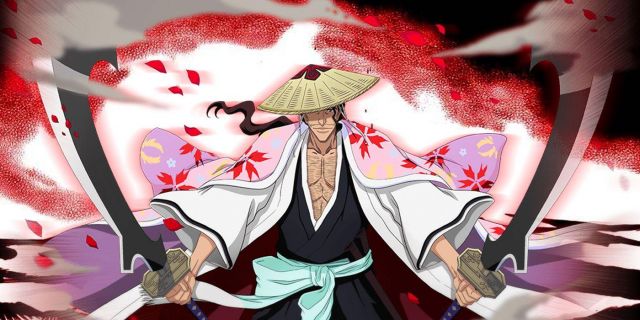Shunsui Kyōraku is the Captain Commander of the Gotei 13 and one of the strongest characters in Bleach. A shrewd tactician with a monstrous pool of Reiatsu, Shunsui demonstrates elite proficiency in standard Shinigami techniques including Kidō, Shunpo and swordplay.
These assets make him more than formidable, and with the addition of his deadliest weapon he is near unstoppable. Shunsui’s most lethal weapon is his Zanpakutō, Katen Kyōkotsu. With abilities mirroring that of Shunsui himself, Katen Kyōkotsu is just as interesting as it is deadly.
What Is Shunsui’s Bankai?

The Shikai command for Katen Kyōkotsu (Flower-Heaven Bone of Madness) is “The flowery winds become disturbed, the God Of Flowers sings, the heavenly winds become disturbed, the Devil of Heaven sneers.” Upon utterance, Shunsui’s katanas transform into dual scimitars, but more than an aesthetic upgrade, Katen Kyōkotsu’s Shikai ability allows Shunsui to bring children’s games to life. Anyone in Katen Kyōkotsu’s area of effect upon release, including Shunsui, becomes a player in the game and is subject to its rules. Rules vary from game to game, but all are played with the understanding that “You win, you live. You lose, you die.”
Katen Kyōkotsu’s Shikai Games, Explained

Bushōgoma (Wobbly Top) emulates a spinning top game that sees Shunsui rotate at high velocities whilst wielding his twin scimitars. This attack can deal damage, disorient and trap those that get caught in the high pressure vortexes created by Shunsui’s rotation. Daruma San ga Koronda (Bodhidharma Falls Down) is essentially a game of red-light green-light; Shunsui designates an opponent as “it” and must travel along the path of their attack’s Reiatsu to “tag” (mercilessly attack) them without being caught (viciously attacked himself). Takaoni (Mountain Demon) boosts the attack power of the person that is literally higher than the other.
Irooni (Color Demon) sees combatants declare a color, both only allowed to strike areas on each other’s person that contain said color. Damage is buffed or nerfed based on how much of the declared color is on the declarer’s person. This rule is a double-edged sword, as in order to deal optimal damage the declarer must choose a color that is amply on their person, meaning that they themselves are also susceptible to heavy damage.
In Kageoni (Shadow Demon) the loser is whoever’s shadow is stepped on, a game that allows Shunsui to deal damage by attacking (stepping on) the shadow of an enemy or any shadow they are standing on. He does so by maneuvering through a pocket dimension created in the shadow he’s attacking from, granting him multiple angles of approach at speeds that make it appear as if he has cloned himself. Kageokuri (Shadow Projection) creates a clone of whoever’s shadow is stared at, with the clone’s strength proportionate to that of the onlooker’s Reiatsu.
The most dangerous aspect of Katen Kyōkotsu is that Shunsui can transition between game seamlessly and without warning. Focusing on one’s shadow is the only way to defend against Kageoni, but this involves staring at the shadow, the starting point for a game of Kageokuri. Therefore, one must account for the possibility that the Shunsui attacking via Kageoni could be a clone produced by Kageokuri. This is one of an incalculable number of strategies at Shunsui’s disposal. This ability to switch at a moment’s notice mirrors children’s tendency to get bored easily, abandoning one game in favor of another even before finishing the first.
Understanding Shunsui’s Bankai Release: Katen Kyōkotsu Karamatsu Shinjū

Katen Kyōkotsu Karamatsu Shinjū (Flower Crazed Heaven Bone Spirit Withered Pine Love Suicide) is Shunsui’s Bankai release. Shunsui holds Katen Kyōkotsu in front of him with its blades faced down as shadows protrude from his body while the spirit of Katen Kyōkotsu embraces him. This release and its shadows distort the environment, transforming it into what Shunsui describes a “dark”, “lonely” and “hopeless” space. This distortion of space means that Shunsui must confirm that his allies are at a safe distance before activating to ensure their safety. Anyone caught inside of the dark and distorted space created by Katen Kyōkotsu’s Bankai release is cast in a 4-act play alongside Katen Kyōkotsu’s Zanpakutō spirit.
Tameraikizu no Wakachiai (The Sharing of Pain) is the first act. Any wounds are shared between Shunsui and his opponent, but cannot prove fatal for either party. The second act is Zanki no Shitone (The Pillow of Shame), and in it the body of Shunsui’s opponent is covered in spots that cause them to bleed profusely, as though afflicted by a highly infectious disease. The third act, Dangyo no Fuchi (The Abyss) plunges both Shunsui and the opponent into an ocean of despair. This body of water is inescapable, as its surface rises endlessly and traps both parties until their Reiatsus are drained. Itokiribasami Chizome no Nodobue (Thread Cut Blood-Soaked Throat) is the final act, an instant-kill technique. Shunsui sheathes his swords as a thread forms around both his finger and the throat of his opponent. Shunsui pulls to tighten the thread wrapped around his opponents’ neck, beheading them.
Katen Kyōkotsu Karamatsu Shinjū tells the tales of a man haunted by regret. Consumed by despair over his actions and unable to die, the man throws himself into the ocean until he is left with nothing. No longer capable of bearing the sight of her partner’s deplorable state, his wife tightens a thread around his neck and kills him. Shunsui serves as the play’s writer and narrator, his opponent cast in the role of the man and Katen Kyōkotsu’s Zanpakutō spirit in that of the woman.
Shunsui’s Shikai and the deadly duality of the games it brings to life mirror Shunsui himself, a shrewd tactician and fierce combatant in spite of his carefree attitude. Karamatsu Shinjū’s tale of a man haunted by regret is one Shunsui lives out daily, carrying immense guilt and sorrow over the death of his brother and execution of lieutenant Nanao Ise’s mother.















Leave a Reply